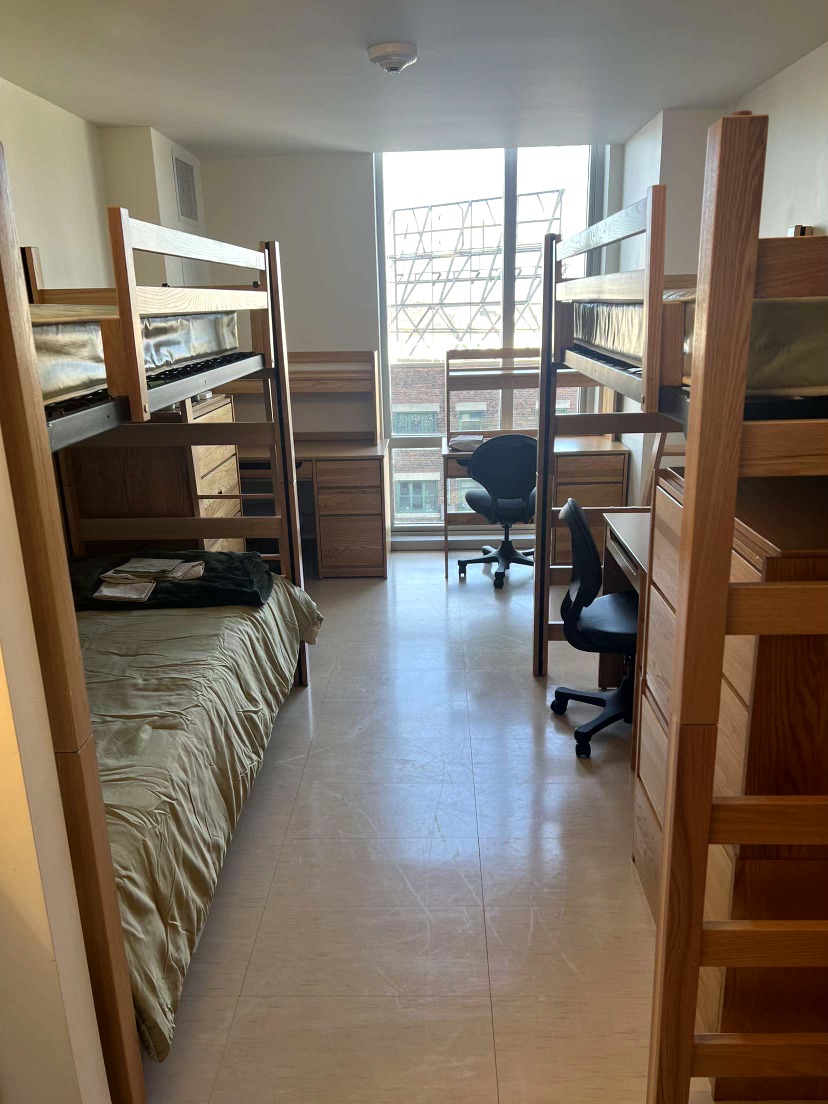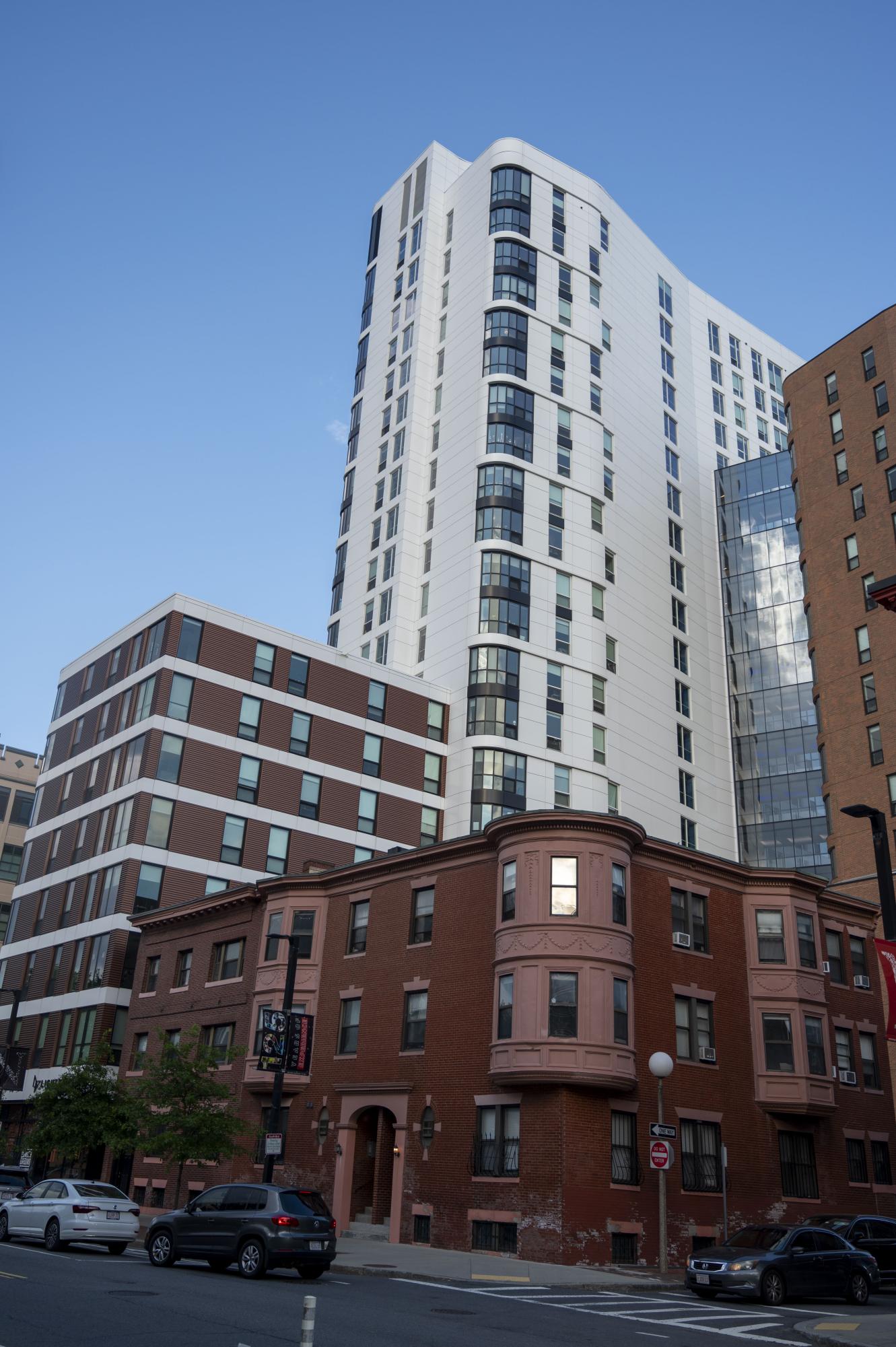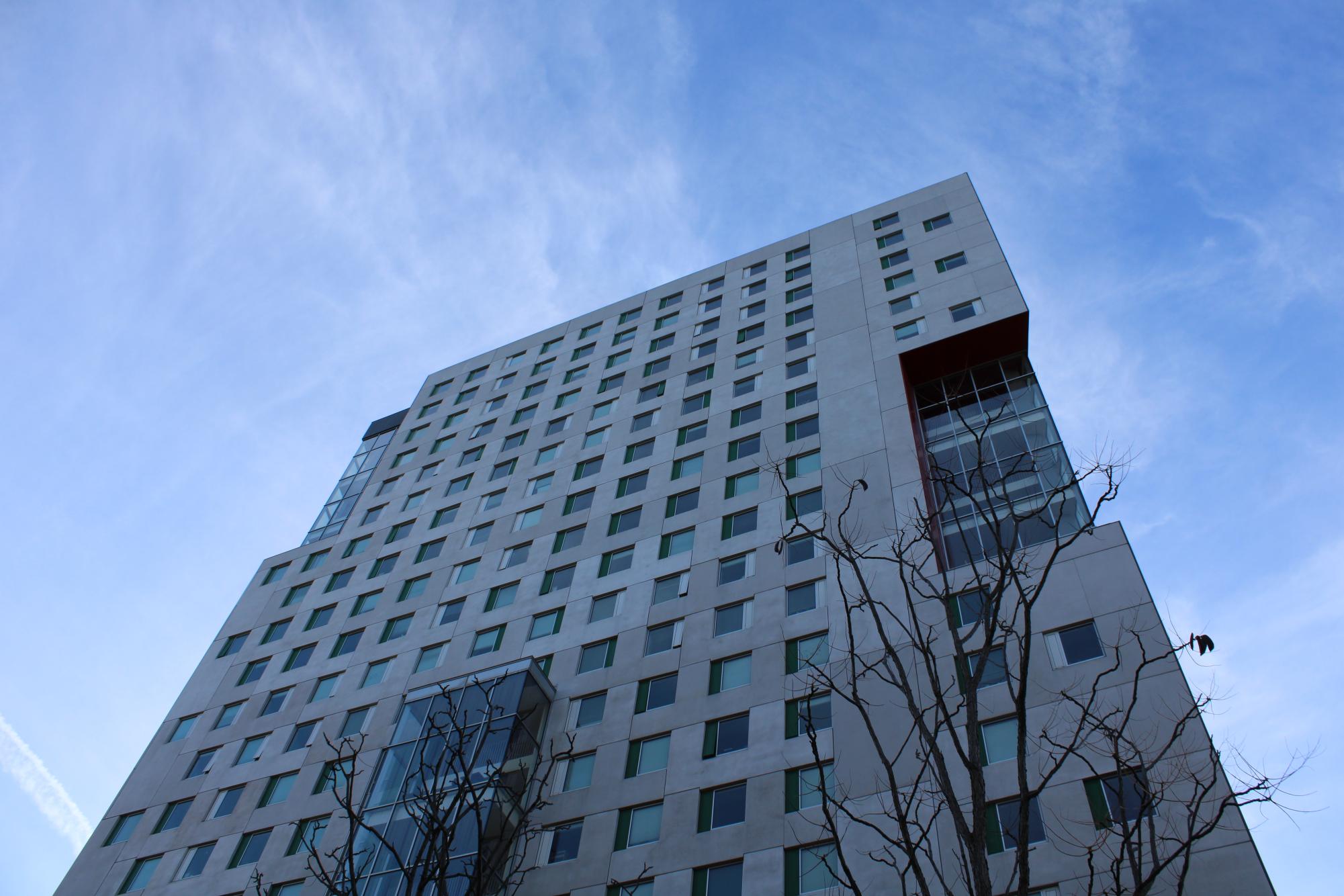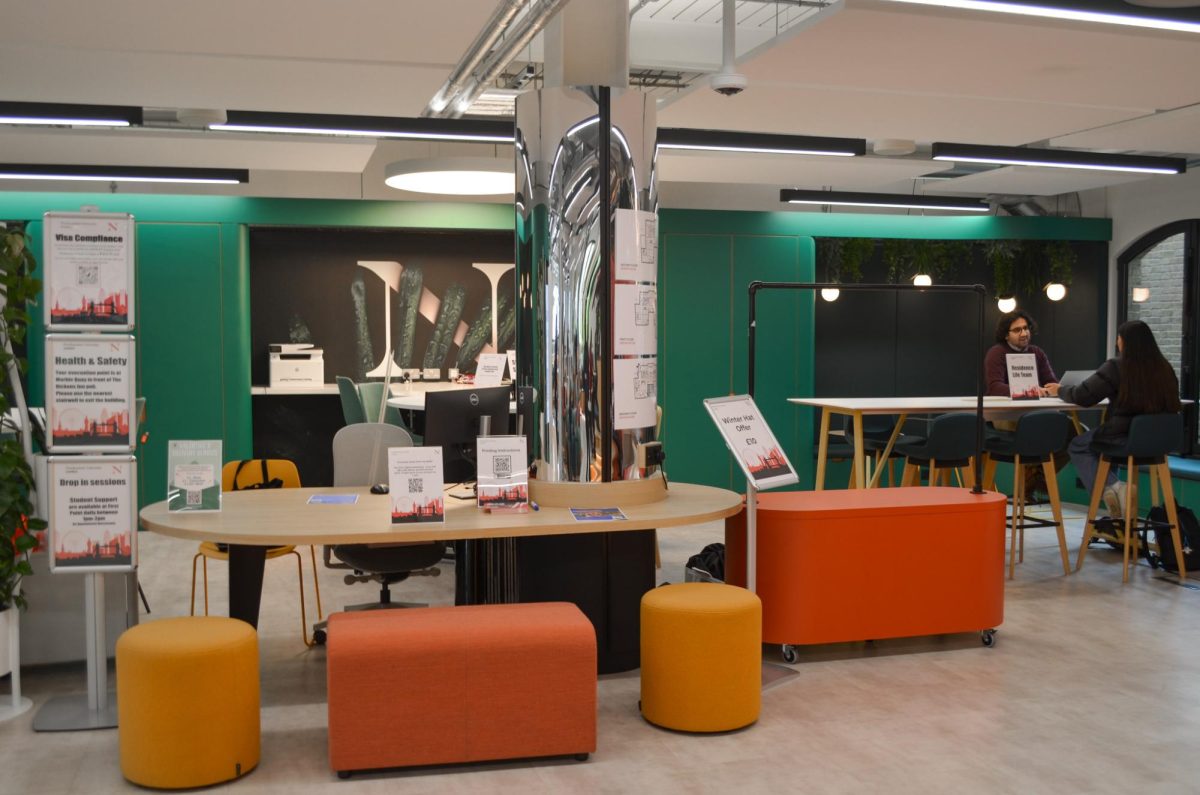With semesterly housing rates approaching $10,000 per semester, Northeastern dorms are more than 25% pricier than they were 20 years ago, when accounting for inflation.
Off-campus housing isn’t much cheaper — a recent report ranked Northeastern the eighth most expensive college to live off-campus in the United States, just behind Harvard (ranked seventh) and Boston University (ranked sixth). The report found that students living off campus at Northeastern can expect to pay around $3,400 a month.
Despite adding more than 5,000 student beds to its on-campus housing supply since 2009, a Wayback Machine search shows that Northeastern’s room rates have only skyrocketed, yet students still have complaints about the university’s living accommodations. The housing crunch has left students in a bind when deciding whether to live on campus or lease an apartment in one of the nearby neighborhoods, the latter of which also poses a problem for long-time residents.
Northeastern has faced a multitude of changes over the past two decades, including its shift from a commuter school to a largely residential, global and increasingly prestigious college. With this comes an expanding student population; the undergraduate student body has nearly doubled over the past 25 years.
Data source: Integrated Postsecondary Education Data System and 2024-2034 IMP
These changes have pushed Northeastern to swallow nearby space, including other school’s dormitories and parking lots. Since 1999, Northeastern has used 9.7 acres of surface parking to construct Davenport A and B, the West Village Complex, 10 Coventry St. apartments, International Village and LightView. This does not include East Village, which was constructed on the site of the former YMCA gymnasium, buildings like Edwards and Rodgers halls, which are leased from Wentworth Institute of Technology, or academic buildings like EXP and the Interdisciplinary Science and Engineering Complex, which took up an additional 2.7 acres of surface parking.
Housing rates have steadily risen 3-5% annually, even when inflation has fluctuated. For instance, rates surpassed inflation by 4.28% and 3.34% in the 2009-10 and 2020-21 academic years, respectively, while off-campus rates dipped as the housing market declined.
Other nearby colleges also continued inflating prices; Boston University’s rate raises surpassed inflation by 5.19% and 2.78% those same years. In fact, nominal house prices in Boston sank 22.5% between 2005 and 2011, according to the Federal Housing Finance Agency’s House Price Index (HPI) Datasets, while nominal room rates at Northeastern and Boston University increased by 25.09% and 28.37%, respectively, between academic years 2005-06 and 2011-12.
According to an analysis of the university’s historical room and board rates by The News, Northeastern has consistently pumped up the prices of its most affordable options at a higher rate than its more expensive ones over the past 20 years.
In 2005, an apartment-style economy triple bedroom cost $1,930 per semester. An apartment-style enhanced studio double that same year cost $4,050. Those were the cheapest and priciest non-single options that year, respectively.
Today, those same rooms cost $4,565 per semester and $7,355 per semester, reflecting a 47.08% and 12.93% increase, respectively, after accounting for inflation.
*Northeastern operated on a Quarter Calendar prior to the 2003-2004 academic year. Data source: Common Data Set and Northeastern University Housing
The same trend is evident in meal plan rates. When the seven-, 12- and 17-meals-per-week plans were first introduced in the 2019-20 academic year, the seven- and 17-meal plans were $2,260 per semester and $3,840 per semester, respectively. By the 2023-24 academic year, these prices had risen to $2,600 per semester and $4,090 per semester, respectively. The price of the seven-meal plan increased more than twice as much as the 17-meal plan did over a four-year span.
Data source: Northeastern Universty
The price of an individual swipe on the lowest meal plan ($12.87 with the 5-meal-per-week plan in 2004-05, $25.00 with the 100-meal-per-semester plan in 2024-25) also increased 18.76% over the past 20 years, when accounting for inflation.
Data source: Northeastern Universty
In a statement to The News, Vice President of Communications Renata Nyul said that the rise in dining rates can be attributed to the evolving structure of the school’s dining offerings, food commodity prices and sourcing changes.
“The way our dining is structured today is very different from 5, 10 or 20 years ago. Food commodity prices have changed which also impacts how food is purchased in a collegiate program; the way food is sourced has changed with an emphasis on local and sustainable purchasing; whilst the pandemic has impacted food prices and sourcing,” Nyul said. “As one example of disruption, student demand has also led to higher quality and variety of offerings as well as more flexibility in the plans we offer — all of this impacting costs.”
For the upcoming 2024-25 academic year, Northeastern has revamped its meal plan offerings with plans by total meals per semester rather than per week. The prices range from $2,700 to $4,300 for the 100 meal and unlimited meal plans per semester, respectively.
Given the high prices, many students choose to live off-campus, where they say they are guaranteed greater flexibility with room options, amenities and living expenses.
“Off-campus apartments are more worth it in the long run. We can cook there and don’t need a meal plan and we have a set place to live if we take summer classes or internships in Boston,” said Mia Mattingly, a rising second-year political science major.
But living off-campus has its downsides. Ryan Fahey, a rising second-year computer science major, considered living off-campus but opted against it due to the distance from campus.
Securing a lease is also challenging.
“You have to look extremely early for a lease, around winter break,” said Deena Weiss, a rising second-year psychology major. “You need to know exactly who you’d be living with and where, and I wasn’t in a position to do that.”
As a result, students are often left with the sole option of on-campus housing, which some say is less than ideal.
“The room I had my first year was an embarrassment,” said Weiss, who lived in an economy double in Smith Hall. “The room was clearly designed to be a single, but they shoved two lofted beds in it. The building was horrible and falling apart.”

Aela Bailey, a rising second-year political science and business administration combined major, said she was in a similar situation her freshman year.
“I was in a forced triple clearly meant for two people, not three. There were literally two closets and two shelves that the three of us fought over,” Bailey said.
In response to questions about whether extra students are placed in dorms that are designed for lower occupancy, Nyul said that “all dorm rooms meet code for the number of occupants.”
Living accommodations aren’t the only thing students have to consider when budgeting for college. Rising prices of meals have left students weighing the decision between living on campus, sometimes without kitchens, and getting a meal plan or renting an off-campus apartment.
“Our meal plan and meals are better than most universities but still don’t suffice for the prices that they are charging us,” Bailey said, noting that Northeastern has more options and better quality food than nearby colleges she has eaten at.
Jesse Garcia, a rising second-year computer science major, also said he liked the food Northeastern offers. “My favorites are the chicken, rice, ice cream, cookies and pizza,” Garcia said. Despite this, he still feels that it isn’t worth the price of the meal plan, emphasizing that he would “rather cook his own chicken and rice.”
But students like Fahey and Mattingly, who have also eaten at other colleges’ dining halls, feel that Northeastern’s food quality is worse and the options are much more limited. Other students feel that Northeastern’s dining halls lack options, particularly for those with specific dietary needs and religious restrictions.
“A lot of the time when I’m trying to find food options, I have no idea if it’s been anywhere near eggs when I’ve had an allergic reaction due to cross-contamination,” said Sydney Rossi, a rising second-year business administration and economics combined major, who has an egg and nut allergy, at a Student Government Association Dining Advisory Board listening session in October 2023. “I’m in a place where I don’t really trust the dining halls because I’m never sure what’s safe and what’s not.”

The only dining hall with a designated kosher and allergy-friendly station is International Village, situated on the opposite side of campus from many freshman dorms, which are designated as housing that requires meal plans.
“I’m required to be in this dorm, required to be on this meal plan, but I don’t have any way to accommodate my own allergies,” Rossi said at the session. “So I’m trying to find ways to work around it, but it’s really difficult, especially how Northeastern’s kind of put me and every freshman in the same box. But the box hasn’t worked for everyone and it’s not working for me.”
Nyul said the university is “responsive” to student demands, including dietary, religious and health-related restrictions, and offers “extensive and inclusive” options in dining halls.
“We are investing more in ingredients, food options, the preparation of the food, the training of staff, etc,” she said. Northeastern Dining has added more gluten-free, vegan and allergy-friendly options in recent years and has a registered dietitian available on Mondays and Thursdays, according to an article by university-run news outlet Northeastern Global News. Food prepared at dining halls in Boston is labeled if it fits a certain diet, like vegan or vegetarian.
In December 2023, Northeastern Dining Services closed the Stetson West Eatery due to “low demand at the time,” according to Nyul, bidding farewell to its beloved stir-fry station and leaving students with two dining halls.
Several students said that the limited hours of Stetson West’s dining hall — which was only open on Mondays to Thursdays from 4 p.m. to 8 p.m. for dinner — deterred them from eating there in the first place. Now, students like Weiss who went to Stetson West’s Eatery three times a week only go there for Outtakes, which offers snacks and meals to go in exchange for meal swipes.

The high prices and perceived low value of on-campus living and dining have driven more students to consider off-campus options, despite logistical challenges. This poses an issue to Roxbury and Mission Hill residents, who have “watched the neighborhood change drastically in a very short period of time.”
“With all the development happening in the area, many families are being displaced and small businesses put in jeopardy,” Roxbury resident and Northeastern student Luis Aponte told The News in 2018.
None of Northeastern’s facilities south of the Orange Line existed prior to 2000 except for Columbus Place, the administrative building where the Northeastern University Police Department is located. Today, residents of nearby neighborhoods say EXP, the Interdisciplinary Science and Engineering Complex, International Village and LightView block views and change the atmosphere of the neighborhood.
The Boston Planning and Development Agency’s, or BPDA’s, approval of Northeastern’s plan to construct a 23-story residence hall at 840 Columbus Ave. raised even more concerns from students that the university is further gentrifying Roxbury neighborhoods. Students are also doubtful that the new dorm will alleviate their concerns; in a 2021 opinion piece for The News, Julianna Milidantri wrote that students need affordable housing options instead of “shiny luxury dorms.”
“Northeastern’s cheapest dorms are often infested by rats and mold and still cost over $900 a month; students can find comparable or cheaper rents in Roxbury, with far better conditions and freedom from residential life rules and proctors,” Milidantri wrote.
There has been a similar influx of students living in Mission Hill, where students can live with greater flexibility at comparable rates. But residents there have complained of “an outburst of rowdy parties and unruly late-night noise complaints that are hard to ignore for many long-time Mission Hill residents.”
“I have a fence around my yard that has wooden pickets, and, without fail, every weekend, there’s a broken picket. There are always red solo cups littered in my yard, too,” Mission Hill resident Candace Belanoff told The News in 2023.

As Northeastern’s next decennial Institutional Master Plan is approved, school stakeholders are working to gather student input on how to improve housing and dining.
Julian Herzing-Burkard, a third-year international business major, is the chair of the Student Government Association’s Campus Planning Advisory Board, or CPAB, which works with Planning Real Estate and Facilities, or PREF, to gather student input.
“We are the official liaison for the student body in terms of opinions and interests related to campus development,” Herzing-Burkard told The News. “We meet weekly as a board and monthly with Campus Planner Connor Sullivan and Director of Campus Planning Cory Berg to discuss upcoming campus projects.”
CPAB is the newest board within the Student Government Association, created in the 2023-24 academic year. Herzing-Burkard, one of the nine members of the board, says he feels fortunate to have the opportunity to have “such unique conversations with the head of planning. No student government equivalent at other schools brings students into campus planning.”
CPAB also collaborates with the Student Sustainability Committee and PREF’s Climate Justice and Sustainability Hub to advance campus sustainability. Student advocacy groups like Diversability also meet with PREF to ensure that disabled and neurodivergent students have their perspectives voiced and needs addressed.
When asked about concerns surrounding the gentrification of nearby neighborhoods, Herzing-Burkard said that the BPDA “mandates that with the construction of any developments Northeastern meets with the community. This provides a mandated avenue for Northeastern to engage with neighboring communities.”
Moving forward, CPAB plans to “reach more students next year and push engagement with as many student organizations as possible on campus,” Herzing-Burkard said.
“We need to make sure we’re reaching the right students at the right time, not just CPAB, but all of campus affairs,” Herzing-Burkard said. As the new 2024-2034 Institutional Master Plan, or IMP, is implemented, Herzing-Burkard said CPAB is “expected to very much continue tabling and collecting student input in terms of open spaces, future developments, etc. An IMP is such a high-level document, [but] at the end of the day it’s just a framework.”
The Huntington News is dedicated to serving the Northeastern University community with original, professional reporting and creating an environment in which student journalists can learn from one another. Support an independent, free press at Northeastern University with your donation today.









